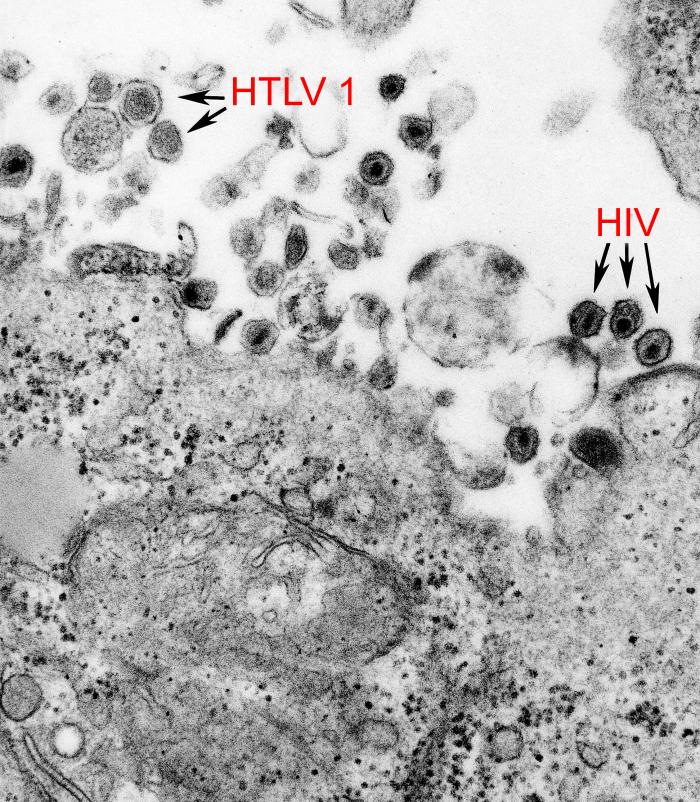Human T- cell Leukemia Virus type 1 (HTLV-1) and type -2 (HTLV-2) are closely related, but distinct retroviruses endemic in Africa. They are highly transmissible and casually linked to different severe diseases.
An epidemiological study carried out in Gabon revealed that the prevalence of HTLV-1 and HTLV-2 is 7.3% and 0.1%, respectively. The prevalence of these retroviruses has escalated over the years from North to South African, varying from 0.6% in Morocco, to 5% in several sub-Saharan countries like Cameroon, Benin, DRC Congo, and Guinea Bissau. HTLV-2 is mostly observed in people in Western Africa.
What is (HTLV-1) and (HTLV-2)?
HTLV is a retrovirus that infects the white blood cells called T-lymphocyte/T-cell. These cells play an important role in the body’s immunity. HTLV (also known as the Human T-cell lymphotropic virus ) falls in the same family as HIV (Human immunodeficiency virus), the only difference is that it doesn’t cause AIDS (Immune Deficiency Syndrome), but they’re transmitted in the same way.
Transmission
HTLV type-1 and type- 2 require cell-to-cell contact for efficient transmission. Transmission occurs through:
- Sexual intercourse
- Mother-to-child transmission during pregnancy
- Sharing of needles and syringes
- Transfusion of cellular blood components
- Breastfeeding
Signs and Symptoms of (HTLV-1) and (HTLV-2)
HTLV-1 and HTLV-2 generally cause no signs and symptoms, although people infected with HTLV-1 might develop HTLV-1 associated myelopathy/ tropical spastic Paraparesis (HAM/TSP), adult T-cell leukemia (ATL), and other diseases.
About 2% of People infected with HTLV-1 will develop HAM/TSP. This is a chronic and progressive nervous system disease. Its signs and symptoms include:
- Unexplained fall
- Constipation
- Urinary inconsistency
- Numbness and pain in the lower limb
- Low back pains
In the later years, patients will experience progressive leg weakness, followed by the exasperation of the urinary and sensory symptoms. While patients might still walk after one or two decades, others might be confident in wheelchairs for months after the onset of the disease.
Those who will develop ATL – a type of cancer caused by the abnormal multiplication of white blood cell might experience symptoms like:
- Fatigue
- Vomiting and nausea
- Skin rash
- Fever and sweats
- Frequent infections
HTLV-1 might also cause arthritis, uveitis, myositis, alveoli is and dermatitis. HTLV-2 isn’t linked to any specific disease, but researcher speculates that it might later result in neurological conditions like:
- Gait Abnormalities
- Sensory neuropathies
- Mild cognitive impairment
- Erectile dysfunction
- Motor abnormalities
Diagnosis
Human T-cell leukemia virus, type 1 and type 2 are often diagnosed based on blood tests to identify antibodies to the virus.
However, most people in Africa suffering from both HTLV-1 and 2 are rarely diagnosed because they never develop any signs or symptoms related to the infection.
They only to discover they have the virus after undergoing screening for blood donation or blood testing for adult T-cell leukemia (ATL) or HTLV-1 associated myelopathy/ tropical spastic Paraparesis (HAM/TSP).
Treatment
There are no specific drugs or vaccine to date for HTLV-1 and HTLV-2. They can only be managed if detected early and prevented from spreading to uninfected persons. People with T-cell lymphoma/leukemia can access various treatments, options like chemotherapy, stem cell transplants, and antiviral drugs.
Promoting safe sex, discouraging the sharing of needles, and screening can lower the number of infections. Mother to child transmission can be managed and reduced by the screening of a pregnant mother, so they can avoid breastfeeding their babies.
References
https://www.cdc.gov/mmwr/preview/mmwrhtml/00021234.htm
https://www.ncbi.nlm.nih.gov/pmc/articles/PMC2901658/
https://jvi.asm.org/content/72/9/7664
https://www.tandfonline.com/doi/abs/10.3109/13550289709015802
https://pubmed.ncbi.nlm.nih.gov/2879950/
https://www.ncbi.nlm.nih.gov/pmc/articles/PMC164244/
https://www.ncbi.nlm.nih.gov/pmc/articles/PMC4678997/
https://www.cancer.org/cancer/hodgkin-lymphoma/treating/high-dose-chemo-and-stem-cell.html
http://htlvaware.com/uploads/2/1/5/5/21557664/htlv_inflam_2014.pdf

